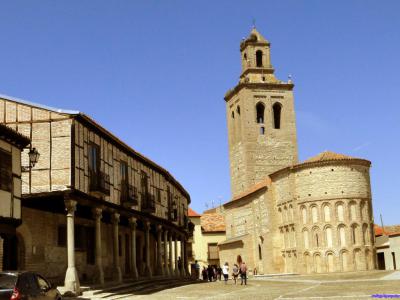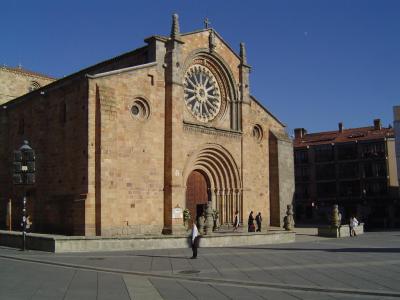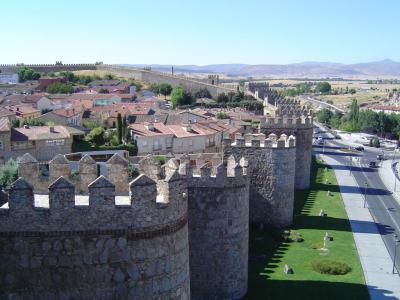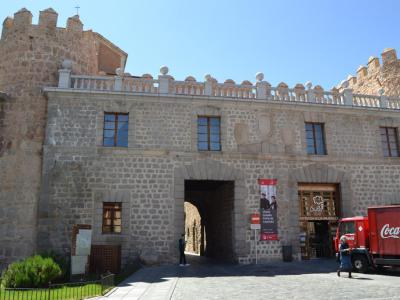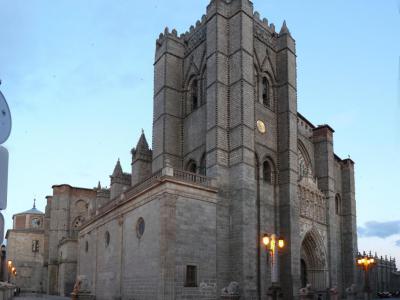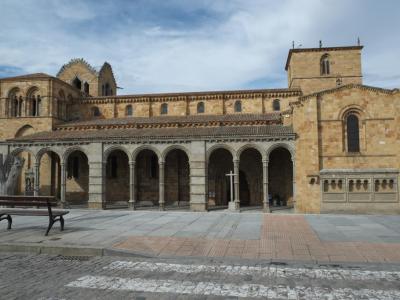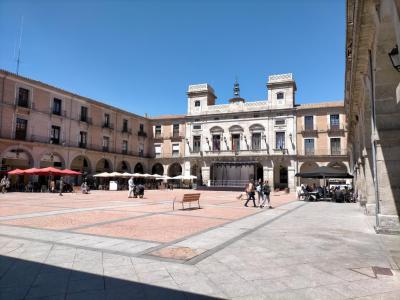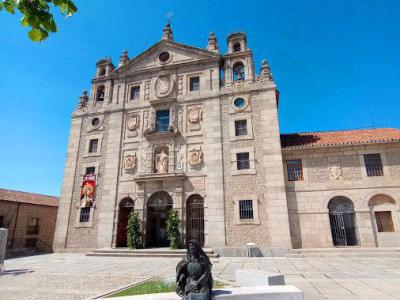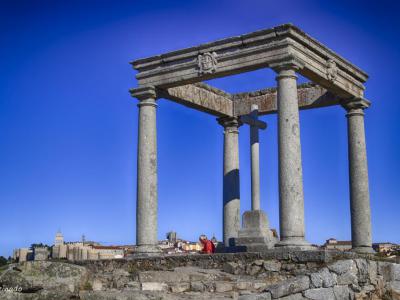
Avila Introduction Walking Tour (Self Guided), Avila
Perhaps the most 16th-century town in Spain, Ávila is the highest provincial capital in the country, perched over 1,130 meters above sea level on the right bank of the Adaja River. The altitude earned the city its name. Ávila's roots date back to pre-Roman times when the area was inhabited by the Vettones who built here a formidable fortress called Obila, meaning "High Mountain". After the Roman conquest, it came to be known as Abila or Abela.
Throughout the early medieval period, Ávila became a stronghold and alternated between Moorish and Christian rule until the 11th century, when many noble families settled here. With its numerous aristocratic palaces, the town became known as "Ávila of the knights", "Ávila of the king", "Ávila of the loyal ones", each of these epithets being present in the town standard.
Distinctively known by its medieval walls, Ávila is also sometimes referred to as the “Town of Stones and Saints,” boasting the highest number of Romanesque and Gothic churches per capita in Spain.
Ávila's heyday was in the 16th century when the mystical following of Santa Teresa de Jesús made it an important pilgrimage destination. Subsequently, Ávila experienced a decline in the 17th century, but in the 19th century, the construction of a railway line brought some growth.
The wealth of exceptional monuments and the old-world ambiance saw Ávila declared a UNESCO World Heritage Site in 1985.
As you traverse the city, make sure to visit Big Market Square (Plaza del Mercado Grande), a bustling spot that has been the heart of commerce and social gatherings for centuries.
The Flour Weight Gate (Puerta del Peso de la Harina) offers another glimpse into Avila's historical past. The nearby Avila Cathedral, a masterpiece of Gothic architecture, is a must-see and true architectural gem, much like the Saint Vincent Basilica, not far away.
For a panoramic view of the city and its surroundings, head to the Viewpoint of the Four Posts (Mirador de los Cuatro Postes) to appreciate Avila's beauty in all its glory.
American filmmaker Orson Welles once named Ávila the place in which he would most desire to live, calling it both strange and tragic at the same time. Inside the perfectly preserved walls of Ávila, visitors are transported to a world where time seems to have stood still since 16th-century. As you explore Avila's historical treasures, just take a moment to reflect on them and feel yourself immersed in their richness...
Throughout the early medieval period, Ávila became a stronghold and alternated between Moorish and Christian rule until the 11th century, when many noble families settled here. With its numerous aristocratic palaces, the town became known as "Ávila of the knights", "Ávila of the king", "Ávila of the loyal ones", each of these epithets being present in the town standard.
Distinctively known by its medieval walls, Ávila is also sometimes referred to as the “Town of Stones and Saints,” boasting the highest number of Romanesque and Gothic churches per capita in Spain.
Ávila's heyday was in the 16th century when the mystical following of Santa Teresa de Jesús made it an important pilgrimage destination. Subsequently, Ávila experienced a decline in the 17th century, but in the 19th century, the construction of a railway line brought some growth.
The wealth of exceptional monuments and the old-world ambiance saw Ávila declared a UNESCO World Heritage Site in 1985.
As you traverse the city, make sure to visit Big Market Square (Plaza del Mercado Grande), a bustling spot that has been the heart of commerce and social gatherings for centuries.
The Flour Weight Gate (Puerta del Peso de la Harina) offers another glimpse into Avila's historical past. The nearby Avila Cathedral, a masterpiece of Gothic architecture, is a must-see and true architectural gem, much like the Saint Vincent Basilica, not far away.
For a panoramic view of the city and its surroundings, head to the Viewpoint of the Four Posts (Mirador de los Cuatro Postes) to appreciate Avila's beauty in all its glory.
American filmmaker Orson Welles once named Ávila the place in which he would most desire to live, calling it both strange and tragic at the same time. Inside the perfectly preserved walls of Ávila, visitors are transported to a world where time seems to have stood still since 16th-century. As you explore Avila's historical treasures, just take a moment to reflect on them and feel yourself immersed in their richness...
How it works: Download the app "GPSmyCity: Walks in 1K+ Cities" from Apple App Store or Google Play Store to your mobile phone or tablet. The app turns your mobile device into a personal tour guide and its built-in GPS navigation functions guide you from one tour stop to next. The app works offline, so no data plan is needed when traveling abroad.
Avila Introduction Walking Tour Map





Guide Name: Avila Introduction Walking Tour
Guide Location: Spain » Avila (See other walking tours in Avila)
Guide Type: Self-guided Walking Tour (Sightseeing)
# of Attractions: 11
Tour Duration: 2 Hour(s)
Travel Distance: 3.0 Km or 1.9 Miles
Author: nataly
Sight(s) Featured in This Guide:
Guide Location: Spain » Avila (See other walking tours in Avila)
Guide Type: Self-guided Walking Tour (Sightseeing)
# of Attractions: 11
Tour Duration: 2 Hour(s)
Travel Distance: 3.0 Km or 1.9 Miles
Author: nataly
Sight(s) Featured in This Guide:
- Plaza del Mercado Grande (Big Market Square)
- Iglesia San Pedro (St. Peter's Church)
- Puerta del Alcazar (Alcazar Gate)
- Murallas (Town Walls)
- Puerta del Peso de la Harina (Flour Weight Gate)
- Avila Cathedral
- Basilica de San Vicente (Basilica of Saint Vincent)
- Plaza del Mercado Chico (Little Market Square)
- Palacio de los Davila (Davila Palace)
- Convento de Santa Teresa (Convent of Saint Teresa)
- Mirador de los Cuatro Postes (Viewpoint of the Four Posts)
1) Plaza del Mercado Grande (Big Market Square)
Big Market Square has a venerable history dating back to the 13th century. It shares a layout akin to the Little Market Square but boasts larger dimensions, making it a focal point for both residents and tourists. This captivating square serves as the beating heart of Ávila, where social interactions take center stage.
Big Market Square provides splendid vistas of two architectural treasures. On one side, you can admire the Romanesque-style Church of San Pedro, a testament to Ávila's rich religious heritage. On the other side, the square offers panoramic views of the city's ancient walls, with a particular focus on the imposing Puerta del Alcázar.
Dominating the square's center is a significant monument—a grand statue of Saint Teresa. This revered figure is perched atop a substantial pillar, serving as a symbol of the city's strong spiritual connection. A fascinating detail often overlooked by many is that the statue of Saint Teresa in Plaza del Mercado Grande gazes purposefully at another statue of Saint Teresa situated nearby, facing the city walls. This interaction between the statues adds depth and intrigue to the square's character.
The square features arcades along its sides, harkening back to its origins when these arches housed artisan shops offering essential goods. Today, these arcades are home to a diverse array of shops that cater to the needs of both locals and tourists. Exploring these shops is a delightful experience, whether you're seeking souvenirs, local products, or artisan crafts.
Big Market Square provides splendid vistas of two architectural treasures. On one side, you can admire the Romanesque-style Church of San Pedro, a testament to Ávila's rich religious heritage. On the other side, the square offers panoramic views of the city's ancient walls, with a particular focus on the imposing Puerta del Alcázar.
Dominating the square's center is a significant monument—a grand statue of Saint Teresa. This revered figure is perched atop a substantial pillar, serving as a symbol of the city's strong spiritual connection. A fascinating detail often overlooked by many is that the statue of Saint Teresa in Plaza del Mercado Grande gazes purposefully at another statue of Saint Teresa situated nearby, facing the city walls. This interaction between the statues adds depth and intrigue to the square's character.
The square features arcades along its sides, harkening back to its origins when these arches housed artisan shops offering essential goods. Today, these arcades are home to a diverse array of shops that cater to the needs of both locals and tourists. Exploring these shops is a delightful experience, whether you're seeking souvenirs, local products, or artisan crafts.
2) Iglesia San Pedro (St. Peter's Church)
Church of Saint Peter is a centuries-old church with a rich history. Its construction dates back to the 12th century, and it has been an important place of worship and a cultural landmark in Ávila ever since.
The church is a fine example of Romanesque and Gothic architecture. Its exterior features robust stone walls and a square bell tower, which are characteristic of the Romanesque style. The Gothic influence is evident in the pointed arches and intricate decorative details.
The Gothic facade of Church of Saint Peter is adorned with beautiful sculptural work, including depictions of saints, biblical figures, and intricate geometric patterns. The portal is particularly noteworthy, showcasing remarkable craftsmanship.
Inside the church, visitors can appreciate the simplicity and elegance of the Romanesque and Gothic styles. The nave has a barrel-vaulted ceiling, while the transept features a stunning rib-vaulted ceiling, typical of the Gothic architectural period. Church of Saint Peter houses a collection of religious art and sculptures. The altarpiece is a notable highlight, as are the chapels and religious artifacts that are part of the church's heritage.
The church is a fine example of Romanesque and Gothic architecture. Its exterior features robust stone walls and a square bell tower, which are characteristic of the Romanesque style. The Gothic influence is evident in the pointed arches and intricate decorative details.
The Gothic facade of Church of Saint Peter is adorned with beautiful sculptural work, including depictions of saints, biblical figures, and intricate geometric patterns. The portal is particularly noteworthy, showcasing remarkable craftsmanship.
Inside the church, visitors can appreciate the simplicity and elegance of the Romanesque and Gothic styles. The nave has a barrel-vaulted ceiling, while the transept features a stunning rib-vaulted ceiling, typical of the Gothic architectural period. Church of Saint Peter houses a collection of religious art and sculptures. The altarpiece is a notable highlight, as are the chapels and religious artifacts that are part of the church's heritage.
3) Puerta del Alcazar (Alcazar Gate)
The Alcázar Gate, like the other gates of Ávila, dates back to the Middle Ages when the city was a fortified stronghold. It was an essential component of the city's defensive walls and played a crucial role in controlling access to the city. The gate is strategically situated in the southwestern part of the city, providing access to the historic center of Ávila.
The gate is a prime example of medieval military architecture. It features a massive stone structure with imposing towers, a drawbridge, and a portcullis. The gate's design was primarily functional, designed to withstand attacks and serve as a secure entrance to the city.
The Alcázar Gate is unique among Ávila's gates because it features a double gate system. This means that it has two sets of gates and walls, creating an extra layer of protection against potential invaders. The interior gate leads to a small courtyard within the city walls.
Today, visitors to Ávila can pass through the Alcázar Gate to enter the historic center of the city. It serves as a picturesque entrance to the well-preserved medieval streets, squares, and landmarks that await exploration within the city walls. From the Alcázar Gate, visitors can also enjoy scenic views of the city's walls, towers, and surrounding landscape, providing excellent photo opportunities.
The gate is a prime example of medieval military architecture. It features a massive stone structure with imposing towers, a drawbridge, and a portcullis. The gate's design was primarily functional, designed to withstand attacks and serve as a secure entrance to the city.
The Alcázar Gate is unique among Ávila's gates because it features a double gate system. This means that it has two sets of gates and walls, creating an extra layer of protection against potential invaders. The interior gate leads to a small courtyard within the city walls.
Today, visitors to Ávila can pass through the Alcázar Gate to enter the historic center of the city. It serves as a picturesque entrance to the well-preserved medieval streets, squares, and landmarks that await exploration within the city walls. From the Alcázar Gate, visitors can also enjoy scenic views of the city's walls, towers, and surrounding landscape, providing excellent photo opportunities.
4) Murallas (Town Walls) (must see)
The Ávila Town Walls have a history dating back to the 11th century, with significant expansions and renovations occurring in the following centuries. They were constructed during the medieval period to protect the city from various threats, including invasions and attacks.
Ávila's Town Walls are renowned for their robust and impressive construction. The walls consist of massive stone blocks and are characterized by their height, thickness, and defensive towers. These walls encompass the entire historic center of Ávila, creating a unique and well-preserved urban fortress. In 1985, the Town Walls were designated as a UNESCO World Heritage Site, recognizing their historical and architectural importance. They are often cited as an outstanding example of medieval military architecture.
The walls feature several gates and defensive towers, each with its own name and history. Some of the most notable gates include the Puerta del Alcázar, Puerta de San Vicente, and Puerta de la Santa.
The walls offer visitors stunning panoramic views of Ávila and the surrounding countryside. You can walk along the top of the walls, providing a unique perspective of the city and a chance to appreciate the walls' imposing structure.
Ávila's Town Walls are renowned for their robust and impressive construction. The walls consist of massive stone blocks and are characterized by their height, thickness, and defensive towers. These walls encompass the entire historic center of Ávila, creating a unique and well-preserved urban fortress. In 1985, the Town Walls were designated as a UNESCO World Heritage Site, recognizing their historical and architectural importance. They are often cited as an outstanding example of medieval military architecture.
The walls feature several gates and defensive towers, each with its own name and history. Some of the most notable gates include the Puerta del Alcázar, Puerta de San Vicente, and Puerta de la Santa.
The walls offer visitors stunning panoramic views of Ávila and the surrounding countryside. You can walk along the top of the walls, providing a unique perspective of the city and a chance to appreciate the walls' imposing structure.
5) Puerta del Peso de la Harina (Flour Weight Gate)
The Flour Weighing Gate is a part of Ávila's medieval city walls and dates back to the Middle Ages, specifically to the 14th century.
The gate's name, "Peso de la Harina," translates to "Flour Weighing." Historically, the gate served as a checkpoint where merchants and traders entering the city were required to weigh their flour and grains. This practice was essential for tax collection and ensuring fair trade within the city.
The gate is characterized by its medieval defensive architecture. It features robust stone walls and towers, typical of fortified gates of that era. The gate's design was primarily functional, serving both as a point of entry and a defensive structure. Surrounding buildings and streets have developed around the gate, making it an integral part of the city's architecture and history.
The gate's name, "Peso de la Harina," translates to "Flour Weighing." Historically, the gate served as a checkpoint where merchants and traders entering the city were required to weigh their flour and grains. This practice was essential for tax collection and ensuring fair trade within the city.
The gate is characterized by its medieval defensive architecture. It features robust stone walls and towers, typical of fortified gates of that era. The gate's design was primarily functional, serving both as a point of entry and a defensive structure. Surrounding buildings and streets have developed around the gate, making it an integral part of the city's architecture and history.
6) Avila Cathedral (must see)
Avila Cathedral, also known as the Catedral de Cristo Salvador, is one of the most important religious and historical sites in Ávila, a city renowned for its well-preserved medieval heritage. Construction of the cathedral began in the 12th century and continued over several centuries, resulting in a blend of architectural styles, including Romanesque and Gothic.
The cathedral's architecture is primarily Gothic, characterized by its pointed arches, ribbed vaults, and soaring vertical lines. The facade features intricate sculptural work, including statues of saints and biblical figures, while the interior is adorned with beautiful stained glass windows, altarpieces, and chapels.
Avila Cathedral is known for its majestic towers, which can be seen from various vantage points throughout the city. The most iconic of these is the Torre del Salvador, a bell tower that reaches a height of approximately 88 meters (289 feet). Visitors can climb to the top of the tower for panoramic views of Ávila.
The cathedral's cloister is a peaceful and beautiful space, offering a respite from the bustling city. It features elegant Gothic arches, a serene garden, and a well-preserved collection of medieval tombs and sculptures.
Avila Cathedral houses a remarkable collection of religious art and treasures, including sculptures, paintings, and religious artifacts. The Chapel of San Segundo is a notable highlight, featuring a stunning altarpiece and a revered relic of the city's patron saint.
The cathedral is an important stop for pilgrims traveling along the Camino de Santiago, a famous pilgrimage route that passes through Ávila. Pilgrims visit the cathedral to seek spiritual solace and blessings on their journey.
The cathedral's architecture is primarily Gothic, characterized by its pointed arches, ribbed vaults, and soaring vertical lines. The facade features intricate sculptural work, including statues of saints and biblical figures, while the interior is adorned with beautiful stained glass windows, altarpieces, and chapels.
Avila Cathedral is known for its majestic towers, which can be seen from various vantage points throughout the city. The most iconic of these is the Torre del Salvador, a bell tower that reaches a height of approximately 88 meters (289 feet). Visitors can climb to the top of the tower for panoramic views of Ávila.
The cathedral's cloister is a peaceful and beautiful space, offering a respite from the bustling city. It features elegant Gothic arches, a serene garden, and a well-preserved collection of medieval tombs and sculptures.
Avila Cathedral houses a remarkable collection of religious art and treasures, including sculptures, paintings, and religious artifacts. The Chapel of San Segundo is a notable highlight, featuring a stunning altarpiece and a revered relic of the city's patron saint.
The cathedral is an important stop for pilgrims traveling along the Camino de Santiago, a famous pilgrimage route that passes through Ávila. Pilgrims visit the cathedral to seek spiritual solace and blessings on their journey.
7) Basilica de San Vicente (Basilica of Saint Vincent) (must see)
The Basilica of Saint Vincent is one of the most important Romanesque churches in the region and holds a special place in Ávila's rich history and heritage. It dates back to the 12th century and is considered one of the finest examples of Romanesque architecture in Spain.
The basilica showcases classic Romanesque architectural features, including thick stone walls, semicircular arches, robust pillars, and decorative sculptural elements. Its exterior is adorned with intricate carvings and reliefs that depict biblical scenes, saints, and various symbolic motifs. One of the distinctive architectural features of the basilica is its three apses, which are semicircular projections at the eastern end of the church. This design element is relatively rare and adds to the uniqueness of the basilica.
Inside the basilica, visitors can admire the elegant simplicity of the Romanesque style. The nave features a barrel-vaulted ceiling supported by sturdy columns. The altar area is richly decorated with a large Gothic altarpiece and other religious artwork.
The basilica is closely associated with the story of Saint Vincent and his sisters, Sabina and Cristeta, who are believed to have been martyred during the Diocletianic Persecution in the early 4th century. Legend has it that their remains were discovered during the construction of the basilica in the 12th century.
While the basilica is a significant historical site, it is still used for religious purposes, hosting Masses, ceremonies, and religious events, making it an active place of worship. Visitors to the basilica can enjoy its architectural beauty, learn about its history through informative displays and guides, and take in the serene and spiritual atmosphere.
The basilica showcases classic Romanesque architectural features, including thick stone walls, semicircular arches, robust pillars, and decorative sculptural elements. Its exterior is adorned with intricate carvings and reliefs that depict biblical scenes, saints, and various symbolic motifs. One of the distinctive architectural features of the basilica is its three apses, which are semicircular projections at the eastern end of the church. This design element is relatively rare and adds to the uniqueness of the basilica.
Inside the basilica, visitors can admire the elegant simplicity of the Romanesque style. The nave features a barrel-vaulted ceiling supported by sturdy columns. The altar area is richly decorated with a large Gothic altarpiece and other religious artwork.
The basilica is closely associated with the story of Saint Vincent and his sisters, Sabina and Cristeta, who are believed to have been martyred during the Diocletianic Persecution in the early 4th century. Legend has it that their remains were discovered during the construction of the basilica in the 12th century.
While the basilica is a significant historical site, it is still used for religious purposes, hosting Masses, ceremonies, and religious events, making it an active place of worship. Visitors to the basilica can enjoy its architectural beauty, learn about its history through informative displays and guides, and take in the serene and spiritual atmosphere.
8) Plaza del Mercado Chico (Little Market Square)
Little Market Square is a charming and historic square that serves as a focal point for both locals and visitors.
The square is surrounded by well-preserved medieval buildings that exhibit a range of architectural styles, including Romanesque and Gothic elements. These buildings often feature intricate stonework, wooden balconies, and ornate facades, adding to the square's charm. These include the City Hall (Ayuntamiento), an historic building graced with an elegant facade, and the Church of San Juan Bautista, a splendid Gothic church featuring an impressive rose window.
Little Market Square is home to numerous cafés, restaurants, and tapas bars, making it an excellent place to enjoy traditional Spanish cuisine or simply relax with a coffee while taking in the surroundings. The square is also a great place for shopping, as it is surrounded by shops and boutiques selling a variety of goods, including souvenirs, handicrafts, and local products.
The square is a vibrant cultural and social hub, hosting various events and gatherings throughout the year. Visitors can often find open-air concerts, festivals, and markets taking place here, adding to the square's lively atmosphere.
The square is surrounded by well-preserved medieval buildings that exhibit a range of architectural styles, including Romanesque and Gothic elements. These buildings often feature intricate stonework, wooden balconies, and ornate facades, adding to the square's charm. These include the City Hall (Ayuntamiento), an historic building graced with an elegant facade, and the Church of San Juan Bautista, a splendid Gothic church featuring an impressive rose window.
Little Market Square is home to numerous cafés, restaurants, and tapas bars, making it an excellent place to enjoy traditional Spanish cuisine or simply relax with a coffee while taking in the surroundings. The square is also a great place for shopping, as it is surrounded by shops and boutiques selling a variety of goods, including souvenirs, handicrafts, and local products.
The square is a vibrant cultural and social hub, hosting various events and gatherings throughout the year. Visitors can often find open-air concerts, festivals, and markets taking place here, adding to the square's lively atmosphere.
9) Palacio de los Davila (Davila Palace)
Dávila Palace showcases a fusion of architectural styles spanning from the 13th to the 16th century. Dávila Palace is closely connected to Ávila's fortified city walls, illustrating its role as part of the city's defensive structure. It served as a second line of defense for the city, along with other palaces and mansions inhabited by nobles and clergy. The palace features architectural elements designed for defense, such as machicolations and merlons on the north front.
The oldest part of the palace appears to be the Gate of the Rastro, which dates back to the 13th century. This gate is an architectural relic and provides a glimpse into the medieval design of the palace.
The palace's architecture is marked by its diverse styles, reflecting the various periods in which it was built. Visitors can observe a juxtaposition of architectural elements, including Gothic and Renaissance styles. The palace evolved over time, with various elements added until the 16th century. The west front, with its geminate windows and pointed Gothic porch, dates back to the 13th century.
Additionally, there are doors and reliefs from the 14th century. A Renaissance window, added in 1541 by Pedro Dávila, is a notable feature of the palace. It is adorned with small columns and the coat of arms of the Dávila family. This window is associated with a legendary phrase: "Where one door closes, another one opens."
An intriguing 16th-century gallery-vantage point on the palace offers spectacular views of the surrounding area, particularly above the Gate of El Rastro.
The palace's courtyard features sculptures of Vetton animals and reflects the influence of the Mudejar architectural tradition, which is evident in various parts of the palace.
The oldest part of the palace appears to be the Gate of the Rastro, which dates back to the 13th century. This gate is an architectural relic and provides a glimpse into the medieval design of the palace.
The palace's architecture is marked by its diverse styles, reflecting the various periods in which it was built. Visitors can observe a juxtaposition of architectural elements, including Gothic and Renaissance styles. The palace evolved over time, with various elements added until the 16th century. The west front, with its geminate windows and pointed Gothic porch, dates back to the 13th century.
Additionally, there are doors and reliefs from the 14th century. A Renaissance window, added in 1541 by Pedro Dávila, is a notable feature of the palace. It is adorned with small columns and the coat of arms of the Dávila family. This window is associated with a legendary phrase: "Where one door closes, another one opens."
An intriguing 16th-century gallery-vantage point on the palace offers spectacular views of the surrounding area, particularly above the Gate of El Rastro.
The palace's courtyard features sculptures of Vetton animals and reflects the influence of the Mudejar architectural tradition, which is evident in various parts of the palace.
10) Convento de Santa Teresa (Convent of Saint Teresa)
The Convent of Saint Teresa holds special significance as it is closely associated with Saint Teresa of Ávila, a revered Spanish mystic, writer, and theologian.
It was founded in 1636 on the site of the birthplace of Saint Teresa of Ávila, who was born in Ávila in 1515. Saint Teresa is a prominent figure in Catholicism, known for her mystical writings and reform efforts within the Carmelite order. Visitors can explore the rooms and chapel of the original house where Saint Teresa was born.
The convent is a fine example of Baroque architecture, characterized by its ornate facades, intricate stonework, and decorative elements. The main entrance to the convent features a beautiful Baroque doorway.
The Convent of Saint Teresa serves as a museum dedicated to Saint Teresa's life and works. It houses a valuable collection of her personal belongings, manuscripts, and religious artifacts. Visitors can gain insight into her life and the spirituality she promoted.
Saint Teresa's Tomb: The convent is also the final resting place of Saint Teresa. Her tomb is an important pilgrimage site for Catholics and admirers of her writings. It is located within the convent's chapel.
Religious Life: The convent remains an active religious center, inhabited by Discalced Carmelite nuns who continue the contemplative and prayerful tradition established by Saint Teresa. The nuns live a secluded life dedicated to prayer, meditation, and devotion.
Visitors to the Convent of Saint Teresa can explore the museum, view Saint Teresa's birthplace, and attend Mass or religious services if they wish. It provides an opportunity to learn about the life and spirituality of Saint Teresa while experiencing the tranquility of the convent.
It was founded in 1636 on the site of the birthplace of Saint Teresa of Ávila, who was born in Ávila in 1515. Saint Teresa is a prominent figure in Catholicism, known for her mystical writings and reform efforts within the Carmelite order. Visitors can explore the rooms and chapel of the original house where Saint Teresa was born.
The convent is a fine example of Baroque architecture, characterized by its ornate facades, intricate stonework, and decorative elements. The main entrance to the convent features a beautiful Baroque doorway.
The Convent of Saint Teresa serves as a museum dedicated to Saint Teresa's life and works. It houses a valuable collection of her personal belongings, manuscripts, and religious artifacts. Visitors can gain insight into her life and the spirituality she promoted.
Saint Teresa's Tomb: The convent is also the final resting place of Saint Teresa. Her tomb is an important pilgrimage site for Catholics and admirers of her writings. It is located within the convent's chapel.
Religious Life: The convent remains an active religious center, inhabited by Discalced Carmelite nuns who continue the contemplative and prayerful tradition established by Saint Teresa. The nuns live a secluded life dedicated to prayer, meditation, and devotion.
Visitors to the Convent of Saint Teresa can explore the museum, view Saint Teresa's birthplace, and attend Mass or religious services if they wish. It provides an opportunity to learn about the life and spirituality of Saint Teresa while experiencing the tranquility of the convent.
11) Mirador de los Cuatro Postes (Viewpoint of the Four Posts) (must see)
The Viewpoint of the Four Posts is situated on a hill just outside the city of Ávila, providing visitors with a stunning perspective of the entire cityscape. It is named after four stone pillars or posts that mark the spot, offering a convenient and elevated platform for taking in the view.
The primary draw of this viewpoint is the spectacular panoramic view it offers of Ávila's historic center, which is enclosed by well-preserved medieval walls. From here, you can appreciate the full grandeur of the city's fortifications, including its towers and gates, as well as the surrounding countryside.
This site holds historical significance, as it is associated with a famous episode in the life of Saint Teresa of Ávila. Legend has it that when she was a child, she and her brother were playing on this hillside when her uncle, who was a member of the Carmelite order, overheard her express a desire to die a martyr's death. Her uncle prophesied that she would indeed die a martyr's death, which later influenced her decision to become a nun.
The Viewpoint of the Four Posts features a stone cross that commemorates Saint Teresa of Ávila. Pilgrims and visitors often leave offerings or light candles at the site, creating a sense of reverence and spirituality.
The viewpoint is easily accessible by car, and there is also a pleasant walking path that leads from the city center to the Four Posts. Many tourists choose to make the short trek to the viewpoint on foot, as it provides an opportunity to enjoy the natural surroundings and take in the scenic beauty along the way.
The Viewpoint of the Four Posts is particularly popular during sunset, as the changing colors of the sky and the dramatic backdrop of the city walls make for a truly magical and romantic experience.
The primary draw of this viewpoint is the spectacular panoramic view it offers of Ávila's historic center, which is enclosed by well-preserved medieval walls. From here, you can appreciate the full grandeur of the city's fortifications, including its towers and gates, as well as the surrounding countryside.
This site holds historical significance, as it is associated with a famous episode in the life of Saint Teresa of Ávila. Legend has it that when she was a child, she and her brother were playing on this hillside when her uncle, who was a member of the Carmelite order, overheard her express a desire to die a martyr's death. Her uncle prophesied that she would indeed die a martyr's death, which later influenced her decision to become a nun.
The Viewpoint of the Four Posts features a stone cross that commemorates Saint Teresa of Ávila. Pilgrims and visitors often leave offerings or light candles at the site, creating a sense of reverence and spirituality.
The viewpoint is easily accessible by car, and there is also a pleasant walking path that leads from the city center to the Four Posts. Many tourists choose to make the short trek to the viewpoint on foot, as it provides an opportunity to enjoy the natural surroundings and take in the scenic beauty along the way.
The Viewpoint of the Four Posts is particularly popular during sunset, as the changing colors of the sky and the dramatic backdrop of the city walls make for a truly magical and romantic experience.
The Most Popular Cities
/ view all
